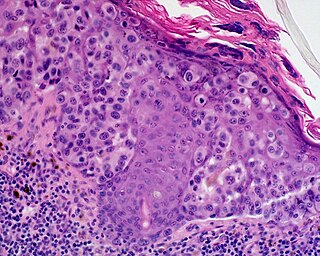
Lichen simplex chronicus (LSC) is a skin disorder characterized by chronic itching and scratching. The constant scratching causes thick, leathery, darkened, (lichenified) skin. This condition is associated with many factors, including the scratch-itch cycle, psychological stressors, and atopy. LSC is more common between ages 35 and 50 and is seen approximately twice as often in women compared to men.
A skin condition, also known as cutaneous condition, is any medical condition that affects the integumentary system—the organ system that encloses the body and includes skin, hair, nails, and related muscle and glands. The major function of this system is as a barrier against the external environment.

Nevus is a nonspecific medical term for a visible, circumscribed, chronic lesion of the skin or mucosa. The term originates from nævus, which is Latin for "birthmark"; however, a nevus can be either congenital or acquired. Common terms, including mole, birthmark, and beauty mark, are used to describe nevi, but these terms do not distinguish specific types of nevi from one another.

A seborrheic keratosis is a non-cancerous (benign) skin tumour that originates from cells in the outer layer of the skin. Like liver spots, seborrheic keratoses are seen more often as people age.

Tinea corporis, also known as ringworm, is a superficial fungal infection (dermatophytosis) of the arms and legs, especially on glabrous skin; however, it may occur on any part of the body. It is similar to other forms of tinea.

Actinic keratosis (AK), sometimes called solar keratosis or senile keratosis, is a pre-cancerous area of thick, scaly, or crusty skin. Actinic keratosis is a disorder (-osis) of epidermal keratinocytes that is induced by ultraviolet (UV) light exposure (actin-). These growths are more common in fair-skinned people and those who are frequently in the sun. They are believed to form when skin gets damaged by UV radiation from the sun or indoor tanning beds, usually over the course of decades. Given their pre-cancerous nature, if left untreated, they may turn into a type of skin cancer called squamous cell carcinoma. Untreated lesions have up to a 20% risk of progression to squamous cell carcinoma, so treatment by a dermatologist is recommended.

Lentigo maligna melanoma is a melanoma that has evolved from a lentigo maligna, as seen as a lentigo maligna with melanoma cells invading below the boundaries of the epidermis. They are usually found on chronically sun damaged skin such as the face and the forearms of the elderly.
Diabetic dermopathy is a type of skin lesion usually seen in people with diabetes mellitus. It is characterized by dull-red papules that progress to well-circumscribed, small, round, atrophic hyperpigmented skin lesions usually on the shins. It is the most common of several diabetic skin conditions, being found in up to 30% of diabetics. Similar lesions can occasionally be found in non-diabetics usually following trauma or injury to the area; however, more than 4 lesions strongly suggests diabetes.

A lentigo is a small pigmented spot on the skin with a clearly defined edge, surrounded by normal-appearing skin. It is a harmless (benign) hyperplasia of melanocytes which is linear in its spread. This means the hyperplasia of melanocytes is restricted to the cell layer directly above the basement membrane of the epidermis where melanocytes normally reside. This is in contrast to the "nests" of multi-layer melanocytes found in moles. Because of this characteristic feature, the adjective "lentiginous" is used to describe other skin lesions that similarly proliferate linearly within the basal cell layer.

Cheilitis is a medical condition characterized by inflammation of the lips. According to its onset and course, cheilitis can be either acute or chronic. Most cheilitis is caused by acute sun exposure. Allergic tests may identify allergens that cause cheilitis.

Eosinophilic granuloma is a form of Langerhans cell histiocytosis. It is a condition of both human and veterinary pathology.
Eruptive vellus hair cysts are small lesions that occur most often in the chest wall, abdomen and extremities, often with a crusted surface. EVHC may occur randomly, or it can be inherited as an autosomal dominant trait. The condition affects males and females equally, and sporadic cases usually appear at 4–18 years of age. The cysts appear similar clinically to steatocystoma multiplex, as well as acneiform eruptions and milia. Therapeutic techniques that are safe and effective are rare, with incision and drainage being the primary form of treatment when sporadic regression does not occur. It was first described in 1977.
Subcutaneous granuloma annulare is a skin condition of unknown cause, most commonly affecting children, with girls affected twice as commonly as boys, characterized by skin lesions most often on the lower legs.
Milker's nodules are a cutaneous condition that is most commonly transmitted from the udders of infected cows. Milker's nodule is caused by Paravaccinia virus. The disease in humans is nearly identical to Orf.
Ink spot lentigo is a cutaneous condition characterized by skin lesions commonly occurring on the shoulders. These lesions often cause alarm but are benign. They are an indication of excessive sun exposure so although ink spot lentigo is not premalignant, people with several of them maybe at increased risk of skin cancer due to UV damage. For a safe diagnosis, they must be flat. Although the shape is irregular, the structure as seen on dermoscopy is very homogenous.
Mucosal lentigines is a cutaneous condition characterized by light brown macules on mucosal surfaces.
Centrofacial lentiginosis is a cutaneous condition characterized by lentigines on the nose and adjacent cheeks.
Partial unilateral lentiginosis is a cutaneous condition characterized by lentigines located on only one half of the body.
Gastrocutaneous syndrome is a rare autosomal dominant cutaneous condition characterized by multiple lentigines.








